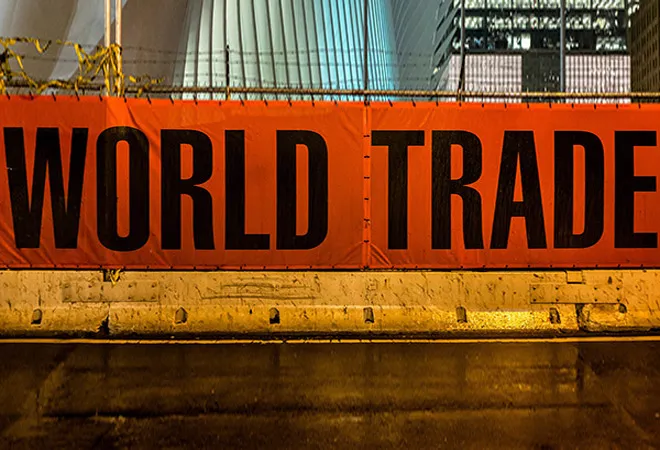 This article is part of the series — Tech in the New Decade.
This article is part of the series — Tech in the New Decade.
The discussion on value chains has heated up since the US-China trade war started in 2018 and, even more so, with the scarcity of certain health products following the outbreak of the COVID-19 pandemic this year. Both geopolitics and security considerations as concerns for the the global supply chain have come to the forefront of the debate, pushing the discussion about the need to reshuffle global value chains further. The central point has been the excessively dominant role of China in global value chains across a whole range of sectors.
Global value chains are not a new phenomenon. They started to expand in the 1950s with the rise of multinationals. The persistently fast growth of international supply chains has been supported by the search for production efficiency by pushing competitive advantage beyond borders. This process was facilitated in the past few decades by the substantial reduction in trade tariffs, as well as transportation and communication costs.
The size of global value chains peaked in 2008.
However, these tailwinds have been fading away for some time and, consequently, the size of global value chains peaked in 2008. Since then, important headwinds such as the US-China trade war and, now the pandemic, have been building up. There is now a growing consensus that global value chains may have become too complex to withstand the emerging global order.
While the trade war and the pandemic have clearly put the resilience of supply chains to a test, there have been previous instances where supply chains have created disruptions in the provision of services at a regional, if not global scale. Two important natural disasters in 2011, the massive floods in Thailand and the earthquake in Japan that caused the nuclear accident in Fukushima, are very good examples. Both events generated a significant shortage in intermediate products that escalated through international linkages in supply chains with very limited capacity to react in the short-term. Thailand’s floods were particularly relevant for the supply of car components in Southeast Asia and Fukushima affected a whole range of supply chains where Japanese components were incorporated.
It is highly improbable that decisions to reshuffle the global value chain away from China, is devoid of economic considerations.
A similar situation was observed at the beginning of this year when production was disrupted in China following the outbreak of the COVID-19 pandemic. Accordingly, the capacity to keep the production process intact, even when a part of the components is affected temporarily by a disruption in production, has become an increasingly important objective for companies. The key question to ask ourselves is: Is the debate on the reshuffling of international supply chains being pushed by political factors or are there also sound economic reasons for it? The answer obviously differs depending on the product as some do hold considerations of national security as seen by the disruption in crucial medical products during the pandemic. On a more general basis, it is highly improbable that decisions to reshuffle the global value chain away from China, is devoid of economic considerations.
The economic rationale for a company to choose a more complex value chain rather than integrating the production domestically, or within a closer geographical area, might no longer be driven by efficiency considerations only. The resilience of the supply of goods has become particularly important as the costs of any disruption have turned out to be very large, as observed this year following the shutter of Chinese factories in February. In addition, within the efficiency rationale behind the decision to offshore the production of parts and components in different locations, many new relevant costs have appeared which might tilt the equation towards a shorter global value chain. First, security issues (from terrorism to cyberattacks) in several countries are pushing up the bill of logistics across borders. Second, environmental risks are on the rise worldwide and so is their potential to generate future disruptions in the supply chain. Third, protectionist measures have found a breeding ground in the inability of the World Trade Organisation (WTO) to ensure compliance with the existing multilateral trading system. And fourth, the increasingly relevant role of technology and the international fragmentation of its standards and legal framework can increase the costs of global value chains operating in different ecosystems. Finally, China’s centrality in the global value chain has resulted in the excessive concentration of risk in one jurisdiction.
The resilience of the supply of goods has become particularly important as the costs of any disruption have turned out to be very large, as observed this year following the shutter of Chinese factories in February.
All in all, while geopolitical and domestic political reasons may be important to explain decisions to reshuffle value chains, there are indeed a number of important economic reasons, as described above, which might explain the decision to either re-shore part of the production or, at least, shorten a company’s supply chain to within a closer geographical boundary whether physically or more figuratively, based on similar standards and legal framework.
The definition of international relations in the next decade remains an important aspect feeding uncertainty about how the value chains reshuffling will look like eventually. At the current juncture, a wide range of scenarios still seem plausible, from cooperation and reciprocal market access to an escalation of protectionism and further fragmentation of standards and institutional frameworks. In the meantime, companies have no alternative but to price this uncertainty in their strategic decisions.
The views expressed above belong to the author(s). ORF research and analyses now available on Telegram! Click here to access our curated content — blogs, longforms and interviews.



 This article is part of the series —
This article is part of the series —  PREV
PREV


